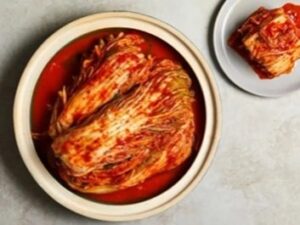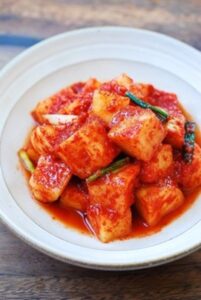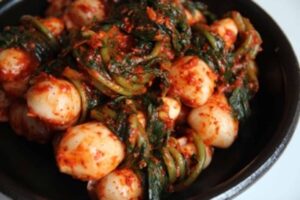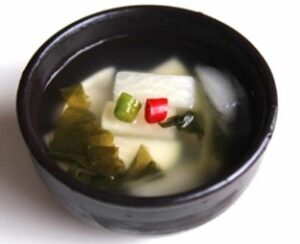Many cultures have their own food that walked alongside them through history, and later evolved, just as Kimchi was made for only Koreans and now is eaten by people globally. As food advanced throughout the years it has been built into society, and dishes became intertwined into one’s culture. Popular dishes such as kimchi can be individualized to different families liking as well as their own recipe. There are about 200 variations of kimchi. Different and famous variations of kimchi in Korea include:
- baechu kimchi made from napa cabbage

(https://www.foodnetwork.com/recipes/food-network-kitchen/baechu-kimchi-11281091)
2. kkakdugi kimchi made from Korean radish

(https://www.koreanbapsang.com/kkakdugi-cubed-radish-kimchi/)
3. chonggak kimchi made from ponytail Radish

(https://www.maangchi.com/recipe/chonggak-kimchi)
4. dongchimi kimchi, a type of watery (mul) kimchi usually consumed as soup in winter.

(https://www.maangchi.com/recipe/dongchimi)
Baechu kimchi is the most consumed kimchi in Korea (Surya & Nugroho, 2023). Despite its popularity, other people may eat other kimchi. Some like to let their kimchi ferment for a few days to a week, two weeks, or even for months. It does not entirely matter how long it sits since kimchi is made using live culture called lactic acid bacteria (LAB) which produce organic acids that help with the unique flavor of kimchi. Not only does kimchi have a unique flavor it also is great for the stomach and has many benefits for nutrients and antioxidants. (Surya & Nugroho, 2023). When looking to buy kimchi it is recommended to look for it in the refrigerated area since this indicates live cultures present in the ferment (J.Halpin, personal communication, November 6, 2024).
Throughout history, Koreans discovered that salted and seasoned vegetables, beans, seafood, and other foods remained edible, and also developed a specific taste after being left in earthenware jars for a certain period. Common seasonings used for making kimchi are garlic, ginger, radish, carrot, green onion, fermented seafood (jeotgal) and red chili powder (gochugaru). The tradition of making kimchi with family has been formed through a long history and includes common attitudes, beliefs, and practices unique to the community.
In a way this tradition reminds me of the way my family makes Tamales, a Mexican dish that takes a whole day to make and cook. Although Tamales are not fermented, the process requires a lot of work, time, and patience. They are made from corn that’s filled with any type of meat commonly used is pork, beef, and chicken, and also contain spices as well, such as cumin seeds, chili powder, jalapeño, and salt. They are wrapped in banana, and or plantain leaf and left on the stove for 1-3 hours to steam. This process of making tamales compares with the way kimchi is made and processed because of the time, and high effort put into making the dish.
As we discussed in class, Kimchi is a traditional dish that has been passed down by many generations, is part of one’s identity, and culture and will be done in many ways. It will always be a comfort food for those who are connected to kimchi dish.
Works Cited:
Surya, R., & Nugroho, D. (2023). Kimchi throughout millennia: A narrative review on the early and modern history of Kimchi. Journal of Ethnic Foods, 10(1). https://doi.org/10.1186/s42779-023-00171-w